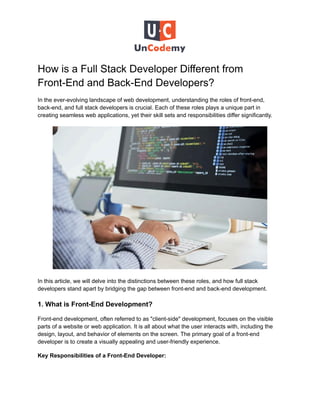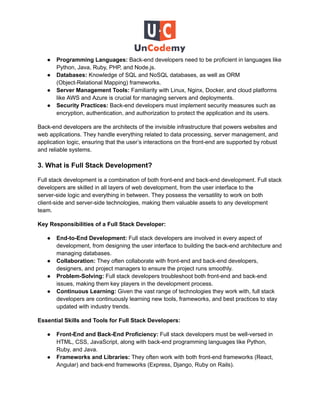How is a Full Stack Developer Different from Front-End and Back-End Developers.pdf
- 1. How is a Full Stack Developer Different from Front-End and Back-End Developers? In the ever-evolving landscape of web development, understanding the roles of front-end, back-end, and full stack developers is crucial. Each of these roles plays a unique part in creating seamless web applications, yet their skill sets and responsibilities differ significantly. In this article, we will delve into the distinctions between these roles, and how full stack developers stand apart by bridging the gap between front-end and back-end development. 1. What is Front-End Development? Front-end development, often referred to as "client-side" development, focuses on the visible parts of a website or web application. It is all about what the user interacts with, including the design, layout, and behavior of elements on the screen. The primary goal of a front-end developer is to create a visually appealing and user-friendly experience. Key Responsibilities of a Front-End Developer:
- 2. ● Design Implementation: Front-end developers take designs created by UI/UX designers and turn them into functional interfaces. ● Responsive Design: Ensuring the website looks good and works well on various devices like desktops, tablets, and smartphones. ● Interaction and User Experience: Implementing animations, buttons, forms, and other interactive elements that enhance the user experience. ● Optimization: Improving website performance and loading times by optimizing images, reducing file sizes, and writing efficient code. Essential Skills and Tools for Front-End Developers: ● HTML, CSS, JavaScript: The building blocks of front-end development. HTML structures the content, CSS styles it, and JavaScript adds interactivity. ● Frameworks and Libraries: Front-end developers often work with frameworks and libraries like React, Angular, or Vue.js to streamline development processes. ● Version Control Systems: Tools like Git help track changes and collaborate with other developers. Front-end developers are primarily concerned with how the application looks and feels. They focus on the aesthetics and usability of a website, ensuring that users have a smooth experience. However, they typically do not handle server-side logic, databases, or the underlying infrastructure of the application. 2. What is Back-End Development? Back-end development, often called "server-side" development, is focused on the parts of a website that users don’t see. It deals with how the website functions, including the server, database, and application logic. While the front-end is responsible for how the application looks, the back-end ensures everything runs smoothly behind the scenes. Key Responsibilities of a Back-End Developer: ● Database Management: Back-end developers are responsible for storing, retrieving, and managing data in databases such as MySQL, PostgreSQL, or MongoDB. ● Server Configuration: Setting up and maintaining web servers, ensuring they are secure and perform efficiently. ● API Development: Creating and managing APIs (Application Programming Interfaces) that allow the front-end and back-end to communicate. ● Business Logic: Implementing the core functionality and logic of the application, ensuring that data is processed correctly and features are executed properly. Essential Skills and Tools for Back-End Developers:
- 3. ● Programming Languages: Back-end developers need to be proficient in languages like Python, Java, Ruby, PHP, and Node.js. ● Databases: Knowledge of SQL and NoSQL databases, as well as ORM (Object-Relational Mapping) frameworks. ● Server Management Tools: Familiarity with Linux, Nginx, Docker, and cloud platforms like AWS and Azure is crucial for managing servers and deployments. ● Security Practices: Back-end developers must implement security measures such as encryption, authentication, and authorization to protect the application and its users. Back-end developers are the architects of the invisible infrastructure that powers websites and web applications. They handle everything related to data processing, server management, and application logic, ensuring that the user’s interactions on the front-end are supported by robust and reliable systems. 3. What is Full Stack Development? Full stack development is a combination of both front-end and back-end development. Full stack developers are skilled in all layers of web development, from the user interface to the server-side logic and everything in between. They possess the versatility to work on both client-side and server-side technologies, making them valuable assets to any development team. Key Responsibilities of a Full Stack Developer: ● End-to-End Development: Full stack developers are involved in every aspect of development, from designing the user interface to building the back-end architecture and managing databases. ● Collaboration: They often collaborate with front-end and back-end developers, designers, and project managers to ensure the project runs smoothly. ● Problem-Solving: Full stack developers troubleshoot both front-end and back-end issues, making them key players in the development process. ● Continuous Learning: Given the vast range of technologies they work with, full stack developers are continuously learning new tools, frameworks, and best practices to stay updated with industry trends. Essential Skills and Tools for Full Stack Developers: ● Front-End and Back-End Proficiency: Full stack developers must be well-versed in HTML, CSS, JavaScript, along with back-end programming languages like Python, Ruby, and Java. ● Frameworks and Libraries: They often work with both front-end frameworks (React, Angular) and back-end frameworks (Express, Django, Ruby on Rails).
- 4. ● Version Control and Deployment: Full stack developers use tools like Git for version control and CI/CD pipelines for deployment and continuous integration. ● Database Management: They are proficient in working with both relational and non-relational databases and understand how to optimize queries for performance. Full stack developers are highly adaptable, capable of switching between front-end and back-end tasks seamlessly. Their ability to work across the full technology stack makes them particularly valuable in startups or small teams where resources are limited, and versatility is essential. 4. Key Differences Between Full Stack, Front-End, and Back-End Developers While all three roles are critical in web development, they differ significantly in terms of scope, responsibilities, and expertise. Let’s explore these differences in detail: ● Scope of Work: ○ Front-end developers focus solely on the user interface and user experience, while back-end developers handle the server-side logic and database management. Full stack developers cover both areas, making them versatile and capable of building complete web applications independently. ● Specialization: ○ Front-end and back-end developers often specialize in their respective areas, diving deep into specific tools and technologies. Full stack developers, on the other hand, are generalists who have a working knowledge of both the front-end and back-end, though they may not delve as deeply into either area. ● Problem-Solving Approach: ○ Front-end developers focus on solving user interface and user experience challenges, while back-end developers are concerned with performance, scalability, and server-side issues. Full stack developers must approach problems holistically, considering both the client-side and server-side implications of their solutions. ● Team Collaboration: ○ In larger teams, front-end and back-end developers often work in silos, focusing on their respective tasks. Full stack developers act as bridges between these teams, ensuring seamless communication and integration of front-end and back-end components. Conclusion In the world of web development, front-end, back-end, and full stack developers all play essential roles. While front-end developers focus on the visual and interactive aspects of a
- 5. website, and back-end developers manage the underlying logic and data, full stack developers combine both skill sets to work across the entire development stack. Their ability to tackle both client-side and server-side challenges makes them highly valuable in the modern tech landscape. For those interested in becoming proficient in both front-end and back-end technologies, pursuing a Full stack Development course in Delhi can provide the comprehensive training needed to excel in this field.





